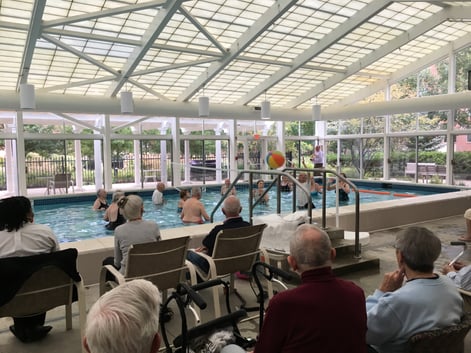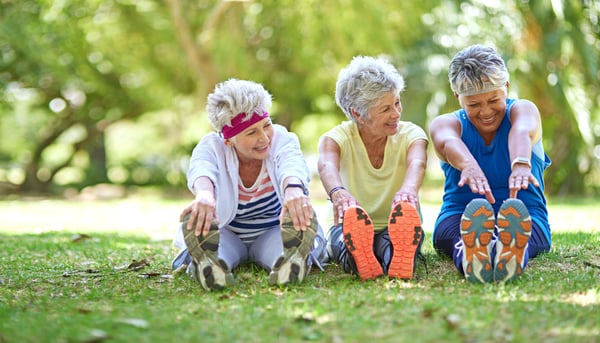It’s well known that being physically active, especially as we age, yields many physical benefits. Examples include decreasing risk factors for chronic diseases, and preserving many aspects of physiological functions, such as cardiovascular function, muscle strength and endurance, as well as balance and flexibility.
In addition to the many physical benefits that you can gain from regular exercise, there are also many psychological benefits. Some of the benefits associated with regular exercise consist of (but are not limited to) improved quality of life and cognitive functioning.
As a fitness instructor I am constantly hearing reasons why individuals feel as though it makes no sense for them to exercise. One example I have heard recently is “I’m 85 years old. What good could taking part in regular exercise do for me? I am too old for there to even be changes made to my strength or balance.” (Hint: This isn’t true!)
Following are three common “excuses” or misconceptions regarding regular exercise that I hear frequently from older adults, and how you can address these concerns.
.jpg?width=521&name=GettyImages-929610028%20(1).jpg) I’m Too Old
I’m Too Old
You might hear: I’m too old to start exercising; its too late to make a difference in my health; it isn’t safe; I don’t want to fall and break a hip; I’m going to get old anyway
To be honest, no one is ever “too old” to start a regular exercise regimen. Many older adults are not aware that regular physical activity has been shown to be beneficial to individuals of all ages, even those well into their 80s, 90s, or older. Besides, inactivity is often associated with the common signs of aging. Older adults often have a fear of falling, especially if they have experienced falls in the past. Thus, these individuals think they are safer or rather better off if they remain sedentary. However, what these older adults don’t realize is that regular exercise is going to help them build strength and stamina, prevent the loss of bone mass, and allow the individual to improve their balance.
How to address this: In addition to discussing how certain exercises are beneficial to oneself especially as we age, instructors should also go over ways to make exercises less scary and thus safer.
I’m Too Busy
You might hear: I’m too busy to exercise; I don’t have time
Many people of all ages don’t realize that exercise does not need to take place at any specific location or at any specific time. Really, exercise is one of those things that shouldn’t be made more complicated than it has to be, and can be made to fit into your daily schedule. Exercises can even be performed in smaller bouts of 10–15 minutes that are repeated a couple times throughout the day, or even simpler exercises that can be connected to certain parts of their routine. Older adults might find exercise to be easier once it is part of a routine.
How to address this: Fitness instructors should guide these older adults on how they can add simple exercises to their daily routines. One example could be practicing a single-legged stance while waiting for their morning coffee to brew.
It’s Too Boring
You might hear: Exercise is boring; exercise is not enjoyable
Most individuals today seem to dread working out and look at it as something that just needs to get done to check it off the to-do list. People often associate exercise with repetitive movements that may be viewed as boring. However, there are a lot of different ways for older adults to make fitness an enjoyable part of their everyday life.
For example, they could take up a sport (such as golf, hiking, or swimming), take a walk with a friend, play with grandchildren, work in the garden, or even take a group fitness class. The key is to at least keep the body in motion, because some movement versus no movement can still be beneficial to their health.
How to address this: Fitness instructors can easily inspire older adults to look at some alternatives that they haven’t considered before but would likely find enjoyable. Instructors can also add components to group fitness classes to make them seem more fun and enjoyable, and less like exercise.
***
The next time you hear one of these excuses from an older fitness client, you’ll know how to encourage them to overcome the misconception and keep moving.


.jpg?width=385&name=GettyImages-482817556%20(1).jpg) The more we age, the less we move, and the more we start to take our health for granted, especially if we have been “healthy” for most of our lives. We often hear about the need to exercise more as we get older, but what about the nutrition aspect? Eating healthy foods is just as important as exercising. There are some good practices and tricks to maintaining a healthy diet and exercising plan as we age.
The more we age, the less we move, and the more we start to take our health for granted, especially if we have been “healthy” for most of our lives. We often hear about the need to exercise more as we get older, but what about the nutrition aspect? Eating healthy foods is just as important as exercising. There are some good practices and tricks to maintaining a healthy diet and exercising plan as we age.


.jpg?width=488&name=Active%20aging-seated%20stretches%20GettyImages-469952165%20(1).jpg)


